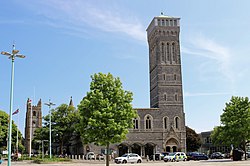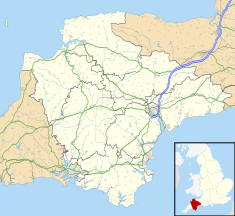|
Plymouth Guildhall
Plymouth Guildhall is located on Guildhall Square in the city centre of Plymouth, Devon, England. It is a Grade II listed building.[1] HistoryThe first guildhall can be dated back to the 15th century and is believed to have been located in the Old Town; it was replaced by a second guildhall which was erected in the Southside Street / Woolster Street area in 1440.[2] A third guildhall was built in the Jacobean style at the junction of High Street and Whimple Street in 1607; this was demolished to allow a fourth guildhall, designed by a Mr Eveleigh, to be built and completed in 1800.[2] The foundation stone for the current building, which was the fifth, was laid by the mayor, William Luscombe, on 28 July 1870.[3] It was designed by Norman and Hine of Plymouth with artistic direction by Edward William Godwin in the Gothic Revival style and built by Messrs Call and Pethick.[3] The building was one of a pair of civic buildings on opposite sides of Guildhall Square which were built at the same time; facing it on the north side of the square was the Municipal Offices, which housed the council's administrative offices and council chamber. The guildhall incorporated courtrooms and a great hall for ceremonial functions and public events. Both buildings were officially opened by Prince of Wales on 13 August 1874.[3][4] The design for the west front of the guildhall, where the entrance now is, involved an octagonal tower on the left and a 50 meters (160 ft) high square tower on the right.[5] Internally, the principal room was the Great Hall: a pipe organ, made by Henry Willis & Sons, was installed in the hall and the first recital given on 22 October 1878.[6] The guildhall and the surrounding buildings, including the municipal offices, were reduced to shells on the night of 21 March 1941 during the Plymouth Blitz of the Second World War.[3] The ruins of the municipal offices were demolished and not rebuilt.[4] Paton Watson and Patrick Abercombie envisaged a Beaux Arts city which would have involved the demolition of the Guildhall: their proposal was rejected by one council vote in 1951.[1] Following the restoration of the building, which involved a new roof, entrances and interior, the building was re-opened by Field Marshal the Viscount Montgomery of Alamein on 24 September 1959.[3] A new headquarters for the city council was completed in 1962 at the Civic Centre, located a short distance to the west of the guildhall.[7] Meanwhile, the assize courts, which had met in the guildhall, moved to the new Law Courts in Armada Way in 1963.[8] DescriptionThe Great Hall is currently a multi-purpose venue, hosting a range of events throughout the year including graduations, award ceremonies, weddings and civil ceremonies.[9] Fourteen stained glass windows, designed by Frederick Halford Coventry (1905-1997), line the sides of the hall and depict notable moments in Plymouth's history.[10] A large 19th century tapestry, made at Gobelins Manufactory, hangs at the front and depicts Raphael's vision of the "Miraculous Drought of Fishes".[10] Famous performers in the hall have included the rock bands The Who in December 1965,[11] Emerson, Lake & Palmer in August 1970,[12] Status Quo in March 1973[13] and Queen in March 1974,[14] as well as the European Union Chamber Orchestra conducted by Julian Lloyd Webber in April 2009.[15][16] References
|
||||||||||||||||||||||||
Portal di Ensiklopedia Dunia

